James Webb Space Telescope (JWST) — A complete guide
JWST is NASA's Big Bang-probing space observatory that is showing us our universe in a whole new light.
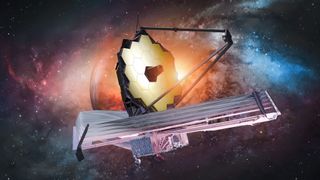
The James Webb Space Telescope (JWST) is the largest and most powerful space telescope to date.
NASA's infrared space observatory, launched on Dec 25, 2021, from ESA's launch site at Kourou in French Guiana, at 7:20 a.m. EST (1220 GMT; 9:20 a.m. local time in Kourou), aboard an Arianespace Ariane 5 rocket.
The $10 billion James Webb Telescope is probing the cosmos to uncover the history of the universe from the Big Bang to exoplanet formation and beyond. It is one of NASA's Great Observatories, huge space instruments that include the likes of the Hubble Space Telescope that peer deep into the universe.
Related: James Webb Space Telescope's best images of all time (gallery)
For the latest mission news and updates, check out our James Webb Space Telescope mission: Live updates page. Read about some of the incredible discoveries JWST has already made as it explores the universe like never before in our 12 amazing James Webb Space Telescope discoveries across the universe article.
Launch date: Dec. 25, 2021.
Cost (at time of launch): $10 billion.
Orbit: JWST will orbit the sun, around the second Lagrange point (L2), nearly 1 million miles (1.5 million kilometers) from Earth.
Primary mirror size: 21.3 feet (6.5 meters) across.
Sunshield: 69.5 ft by 46.5 ft (22 meters x 12 meters).
Mass: 14,300 lbs (6,500 kg).
It took 30 days for the JWST to travel nearly a million miles (1.5 million kilometers) to its permanent home: Lagrange point 2 — a gravitationally stable location in space. The telescope arrived at L2, the second sun-Earth Lagrange point on Jan. 24, 2022.
L2 is a spot in space near Earth that lies opposite the sun; this orbit allows the telescope to stay in line with Earth as it orbits the sun. It has been a popular spot for several other space telescopes, including the Herschel Space Telescope and the Planck Space Observatory.
Related: How the James Webb Space Telescope works in pictures
According to NASA, the James Webb Space Telescope will focus on four main areas: the first light in the universe, the assembly of galaxies in the early universe, the birth of stars and protoplanetary systems, and planets (including the origins of life.)
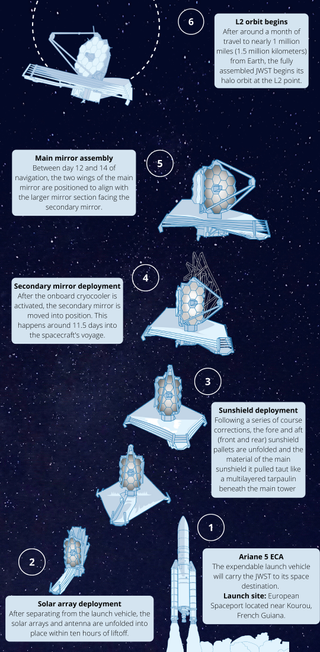
On July 11, 2022, NASA announced that all 17 of the observatory scientific instrument 'modes' had been fully vetted and that the James Webb Space Telescope was ready to begin its epic science mission.
The powerful JWST is taking amazing photos of celestial objects like its predecessor, the Hubble Space Telescope. Luckily for astronomers, the Hubble Space Telescope remains in good health and the two telescopes will work together for JWST's first years. JWST will also look at exoplanets previously identified by the Kepler Space Telescope and follow up on real-time observations from ground space telescopes.
The James Webb Telescope is the product of an impressive international collaboration between NASA, the European Space Agency (ESA), and the Canadian Space Agency. According to NASA, the JWST involved over 300 universities, organizations and companies across 29 U.S. states and 14 countries.
James Webb Space Telescope FAQs answered by an expert
We asked Naomi Rowe-Gurney, a postdoctoral research associate at the NASA Goddard Space Flight Center some commonly asked questions about the powerful space telescope.

Naomi Rowe-Gurney is a postdoctoral research associate at the NASA Goddard Space Flight Center employed by the University of Maryland College Park. She is also a solar system ambassador for the James Webb Space Telescope.
How does the James Webb Space Telescope (JWST) work?
The JWST works very much like any telescope in that its main job is to capture light and focus it so we can see further into the distance. There are a lot of differences though like JWST sees in a different part of the electromagnetic spectrum than our eyes do. We see visible light but JWST sees infrared or "heat", just like a night vision security camera. It's also really big so it can capture a lot more light and therefore see more distant, smaller, and colder objects. This is also helped by it being in space because it doesn't have to look through the atmosphere, which blocks a lot of really useful and interesting information.
How far can the James Webb Space Telescope "see"?
Why does this distant view allow the JWST to see galaxies in the early universe?
The further away in the universe something is the faster it is traveling away from us. Fast things experience something called redshift and this makes the object appear redder. Eventually, when something is so far away it gets even redder than red and becomes infrared. This is why JWST can see further than any telescope we've had before.
Light takes time to travel to us, so the furthest away objects are also the oldest. Telescopes like Hubble and JWST look back in time. JWST can see further than Hubble because it is in the infrared so it can look almost to the beginning of the universe, 13.7 billion years ago.
Where is the James Webb Space Telescope now?
The JWST orbits around a point in space called the L2 Lagrange point. This is 1.5 million km away from us so that the heat from Earth doesn't get in the way of what it's looking at. L2 is a gravity well so we can use less fuel to keep it there than if it was just floating at a random point in space. It is also useful that L2 follows us around the sun, so we are always able to communicate and download images from the telescope.
Of the observations the JWST has made thus far, which is the most exciting for you?
I am a planetary scientist, so I am interested in everything in our own solar system! I especially love the ice giants Uranus and Neptune because we know so little about them. I did my Ph.D. looking at the atmospheres of both planets using the Spitzer Space Telescope which was like a mini-JWST. It was so mini that we couldn't get any images and had to look at the planet like it was as small as a distant star, so the first images of both of those planets have been the most exciting for me.
James Webb Space Telescope launch and deployment
NASA's JWST launched on Dec 25, 2021, from ESA's launch site at Kourou in French Guiana, at 7:20 a.m. EST (1220 GMT; 9:20 a.m. local time in Kourou), aboard an Arianespace Ariane 5 rocket.
Thanks to a successful and precise launch, NASA announced that the JWST should have enough fuel to more than double its minimum mission life expectancy of 10 years. Since, its launch, the James Webb Space Telescope's accomplishments just keep on coming.
The James Webb Space Telescope is currently located at L2, the second sun-Earth Lagrange point. L2 is a spot in space near Earth that lies opposite the sun. You can keep track of Webb in more detail with NASA's Where is Webb Website.
An impressive HD video captured the observatory flying away from the Ariane 5 rocket that carried it into space. The three-minute video shows Webb slowly drifting away from its rocket stage and unfurling its solar panels.
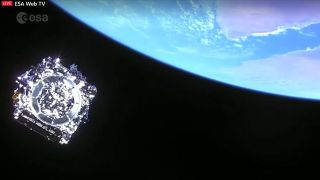
The James Webb Telescope deployed and tested a key antenna on Dec. 26, 2021, in a process that took about one hour, according to a NASA statement. The antenna will be responsible for twice-daily science data dumps to Earth. Just a day later, on Dec. 27, the observatory sailed beyond the orbit of the moon.
On Dec. 31, 2021, Webb successfully unfurled its massive sunshield. The tensioning of the sunshield's five layers began on Jan, 3. 2022 and was completed the next day. The telescope's secondary mirror was then successfully deployed and latched on Jan. 5, 2022.
Then on Jan, 8. 2022, NASA announced that the James Webb Space Telescope had successfully unfolded the giant primary mirror and is now fully deployed. The next step for Webb is the alignment of the 18 individual mirrors that make up the observatory's primary mirror. NASA estimates the work could take up to 120 days after launch for the alignment to be complete.
The James Webb Space Telescope reached its final destination: L2, the second sun-Earth Lagrange point, which it will orbit, on Jan, 24. 2022 after traveling nearly a million miles (1.5 million kilometers).
James Webb Space Telescope images
The James Webb Space Telescopes' first science images were officially released by NASA during a live event on July 12, at 10:30 a.m. EDT (1430 GMT). They included the Cosmic Cliffs in the Carina Nebula, the striking Southern Ring Nebula, Stephan's Quintet and an analysis of the atmospheric composition of the hot gas giant exoplanet WASP-96 b.
Related: James Webb Space Telescope's 1st photos (gallery)
"You know what I'm most excited about?" Thomas Zurbuchen, NASA's associate administrator for science, said during the event after the images were revealed. "There's tens of thousands of scientists — and frankly, some of them just got born or are not even born — who are benefiting from this amazing telescope because it will be with us for decades."
Related: Behold! The James Webb Space Telescope's stunning 1st science images are here.
A day earlier on July 11, 2022, President Joe Biden, Vice President Kamala Harris and NASA Administrator Bill Nelson unveiled the first science-quality image captured by the James Webb Space Telescope.
The stunning image shows the deepest infrared view of the universe to date, according to a NASA statement, and was created using just 12.5 hours of observing time on one of the telescope's four instruments.

Prior to the first image and data release, Webb had already treated us to several impressive images during its instrument checks.
On Feb, 11. NASA announced that The JWST had captured its first images of starlight. The first image taken by Webb was of a star called HD 84406. Light from HD84406 was captured by Webb's 18 mirror segments located on the primary mirror, resulting in a mosaic of 18 scattered bright dots.
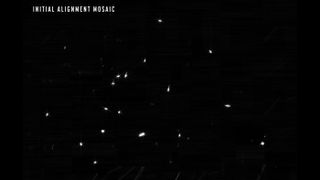
"As Webb aligns and focuses over the next few months, these 18 dots will slowly become a single star," Thomas Zurbuchen, NASA's Associate Administrator for the Science Mission Directorate, said on Twitter.
On Feb, 18. NASA released a new and improved image of HD84406, bringing 18 unfocused copies of a star into a deliberate hexagonal formation. Once the observatory has successfully aligned the individual segments of the primary mirror it will begin the image stacking process. This will bring 18 images on top of each other into one clear view.
Webb has also taken an impressive "selfie" using a specialized camera inside the NIRCam instrument. The camera is designed to be used for engineering and alignment purposes.
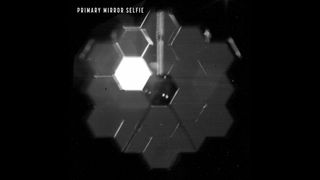
In the "selfie" you can see one of the mirror segments is shining brighter than the others, this is because it is the only segment at the time successfully aligned and pointing at a star. The rest of the mirror segments were successfully aligned one by one.
On April 28, NASA announced in a statement that the James Webb Space Telescope had finished its alignment phase after demonstrating it can capture "crisp, well-focused images" will all four of its scientific instruments.
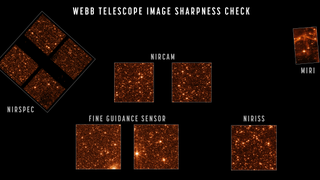
On July 11, 2022, President Joe Biden, Vice President Kamala Harris and NASA Administrator Bill Nelson unveiled the first science-quality image captured by the James Webb Space Telescope.
The stunning image shows the deepest infrared view of the universe to date, according to a NASA statement, and was created using just 12.5 hours of observing time on one of the telescope's four instruments.
James Webb Space Telescope science mandate
JWST's science mandate is principally divided into four areas:
First light and reionization
This refers to the early stages of the universe after the Big Bang started the universe as we know it today. In the first stages after the Big Bang, the universe was a sea of particles (such as electrons, protons and neutrons), and the light was not visible until the universe cooled enough for these particles to begin combining. Another thing JWST will study is what happened after the first stars formed; this era is called "the epoch of reionization" because it refers to when neutral hydrogen was reionized (made to have an electric charge again) by radiation from these first stars.
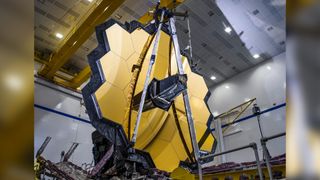
Assembly of galaxies
Looking at galaxies is a useful way to see how matter is organized on gigantic scales, which in turn gives us hints as to how the universe evolved. The spiral and elliptical galaxies we see today actually evolved from different shapes over billions of years, and one of JWST's goals is to look back at the earliest galaxies to better understand that evolution. Scientists are also trying to figure out how we got the variety of galaxies that are visible today, and the current ways that galaxies form and assemble.
Birth of stars and protoplanetary systems
The Eagle Nebula's "Pillars of Creation" are some of the most famous birthplaces for stars. Stars come to be in clouds of gas, and as the stars grow, the radiation pressure they exert blows away the cocooning gas (which could be used again for other stars, if not too widely dispersed.) However, it's difficult to see inside the gas. JWST's infrared eyes will be able to look at sources of heat, including stars that are being born in these cocoons.
Planets and origins of life
The last decade has seen vast numbers of exoplanets discovered, including with NASA's planet-seeking Kepler Space Telescope. JWST's powerful sensors will be able to peer at these planets in more depth, including (in some cases) imaging their atmospheres. Understanding the atmospheres and the formation conditions for planets could help scientists better predict if certain planets are habitable or not.
James Webb Space Telescope onboard instruments
The JWST is equipped with four science instruments that will enable observations in visible, near-infrared and mid-infrared (0.6 to 28.5 micrometers) wavelengths.
James Webb Space Telescope vs. Hubble Space Telescope
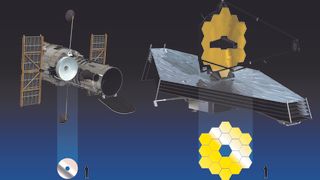

Scientific advancement is all about "standing on the shoulders of giants" and the JWST is doing just that, as its scientific goals were motivated by the results from the Hubble Space Telescope.
The two space telescopes have different capabilities, whilst Hubble primarily observed the cosmos in optical and ultraviolet wavelengths (with some infrared capabilities.) The JWST is primarily looking at the universe in infrared. Due to the expansion of the universe, light from distant objects shifts to longer wavelengths at the redder end of the spectrum — known as redshift, according to ESA. The JWST will observe this infrared light in great detail and shed light on some of the oldest stars and galaxies in the universe.
Another big difference between the James Webb Space Telescope and the Hubble Space Telescope is that JWST orbits the sun, whilst Hubble orbits Earth. JWST will be too far away to be serviced, unlike Hubble which was accessed and serviced by space shuttle missions.
James Webb Space Telescope delays
Good things come to those who wait.
The JWST was first slated to fly in 2007 and since then astronomers' patience has been sternly tested. A mix of engineering problems, political hesitancy and project management issues have all contributed to countless delays.
In July 2011, U.S. politicians threatened to pull funding for the JWST. After a nail-biting few months, the spacecraft was saved in November 2011. Then in March 2018, the launch of JWST was delayed due to technical issues with the spacecraft. Later that year in June, an independent review board recommended the launch be moved to March 2021.
In 2020, The global coronavirus (COVID–19) pandemic impacted JWST's progress and in July 2020, NASA announced a new launch date of October 31, 2021. Despite the perseverance and determination of the JWST team during a difficult time, the delays kept coming.
In June 2021, problems with the Ariane 5 launch vehicle pushed the launch date back to November or possibly early December 2021. Then in September NASA and ESA announced yet another delay as the observatory had not yet been shipped from its original location in California to ESA's launch site at Kourou in French Guiana. The two agencies announced a new launch date of Dec.18, but bad weather soon put a stop to that.
Finally, the JWST successfully launched on Dec 25, 2021, from ESA's launch site at Kourou in French Guiana.
Naming of the James Webb Space Telescope: Controversy
The space telescope was previously known as the Next Generation Space Telescope and was renamed the James Webb Space Telescope in Sept. 2002.
The JWST is named for former NASA chief James Webb. Webb took charge of the space agency from 1961 to 1968, retiring just a few months before NASA put the first man on the moon.
Although Webb's tenure as NASA administrator is most closely associated with the Apollo moon program, he is also considered a leader in space science. Even in a time of great political turmoil, Webb set NASA's science objectives, writing that launching a large space telescope should be a key goal of the space agency.
NASA launched more than 75 space science missions under Webb's guidance. They included missions that studied the sun, stars and galaxies as well as space directly above Earth's atmosphere.
Not everyone is happy with the choice of name for the space telescope. An online petition was set up by critics urging NASA to rename the telescope due to claims that Webb was complicit in discrimination against gay and lesbian NASA employees during his tenure. NASA has since said it will not rename the telescope despite complaints.
Additional resources
You can learn how the JWST is designed to answer some of the biggest questions in the universe with the UK Space Agency and explore it's impressive mirrors with NASA. Keep yourself and others entertained with these fun facts and a folding puzzler from Northrop Grumman.
Bibliography
- Astrophysics in the Next Decade: The James Webb Space Telescope and Concurrent Facilities (Astrophysics and Space Science Proceedings).
- NASA's James Webb Space Telescope: JWST observations in the solar system.
- Gardner et al. "The James Webb Space Telescope", Space Science Reviews, Volume 123, 2006. DOI: 10.1007/s11214-006-8315-7
Join our Space Forums to keep talking space on the latest missions, night sky and more! And if you have a news tip, correction or comment, let us know at: community@space.com.
Get the Space.com Newsletter
Breaking space news, the latest updates on rocket launches, skywatching events and more!

Elizabeth Howell (she/her), Ph.D., is a staff writer in the spaceflight channel since 2022 covering diversity, education and gaming as well. She was contributing writer for Space.com for 10 years before joining full-time. Elizabeth's reporting includes multiple exclusives with the White House and Office of the Vice-President of the United States, an exclusive conversation with aspiring space tourist (and NSYNC bassist) Lance Bass, speaking several times with the International Space Station, witnessing five human spaceflight launches on two continents, flying parabolic, working inside a spacesuit, and participating in a simulated Mars mission. Her latest book, "Why Am I Taller?", is co-written with astronaut Dave Williams. Elizabeth holds a Ph.D. and M.Sc. in Space Studies from the University of North Dakota, a Bachelor of Journalism from Canada's Carleton University and a Bachelor of History from Canada's Athabasca University. Elizabeth is also a post-secondary instructor in communications and science at several institutions since 2015; her experience includes developing and teaching an astronomy course at Canada's Algonquin College (with Indigenous content as well) to more than 1,000 students since 2020. Elizabeth first got interested in space after watching the movie Apollo 13 in 1996, and still wants to be an astronaut someday. Mastodon: https://qoto.org/@howellspace
